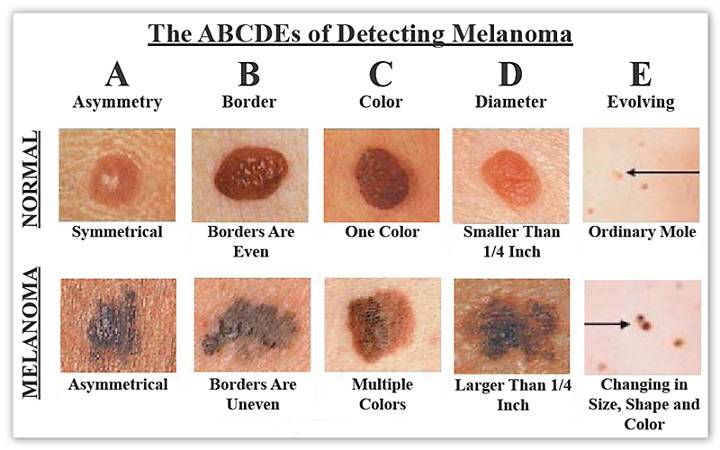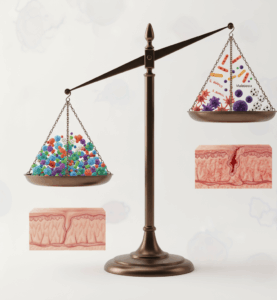 The ABCDE guide is a useful tool for spotting melanoma, although there can be varying signs and there are other types of skin cancer.
The ABCDE guide is a useful tool for spotting melanoma, although there can be varying signs and there are other types of skin cancer.
Guide to Moles and Melanoma: Early Detection Saves Lives
Skin cancer can develop anywhere on the body and may present in various ways. The ABCDE guide is a useful tool for spotting melanoma, the most serious form of skin cancer, but it’s important to remember that other types of skin cancer exist and may show different signs.
Unexpected changes on your skin that do not heal quickly deserve a professional check. However, you are in the best position to monitor your skin regularly — a quick monthly self-examination only takes a few minutes and can be life-saving.
Why Regular Skin Checks Matter
Skin cancers often develop in areas with higher sun exposure, such as the scalp, face, chest, arms, and hands, or on the legs in women. But skin cancer can also appear in less visible places, so a thorough check of your entire body is critical.
By learning how to examine your skin properly and making it a routine, you increase the chances of detecting skin cancers early, when treatment is less invasive and more effective.
How to Perform a Monthly Skin Self-Examination
Preparation:
- Find a well-lit room with a full-length mirror and a hand-held mirror.
- Use a comb or brush to part your hair.
- Having a partner to assist you can be helpful, but it is not essential.
Step-by-Step Check:
- Facial Area:
Check your nose, lips, eyelids, ears (front and back), and neck. Use mirrors to inspect hard-to-see areas behind your ears. - Scalp and Hairline:
Use a comb or brush and mirrors to inspect your scalp thoroughly, especially hairline edges and areas of hair thinning or loss. - Arms and Wrists:
Start from your armpits and move down your arms to your hands, including palms, between fingers, and under nails. - Back of Arms and Shoulders:
Use mirrors to view the back of your arms and shoulders, areas often exposed to the sun but hard to see. - Chest and Torso:
Inspect from your neck down to your groin. Women should lift their breasts to check underneath. - Back of Your Body:
Use a hand-held mirror and a full-length mirror to check your upper and lower back, neck, and buttocks. - Legs and Feet:
Check the front and back of your legs, including soles, toes, nails, and between toes.
Use Your Sense of Touch
Feeling your skin as you examine it can help detect unusual lumps, bumps, or texture changes, especially in less visible areas.
The ABCDEs of Melanoma
Use this guide to evaluate moles or spots:
- Asymmetry: One half doesn’t match the other.
- Border: Edges are irregular, scalloped, or poorly defined.
- Colour: Varied shades of brown, black, tan, or even white, red, or blue.
- Diameter: Greater than 6mm (about the size of a pencil eraser), though melanomas can be smaller.
- Evolving: Any change in size, shape, colour, or symptoms such as itching or bleeding.
If you notice any new, changing, or unusual spots, see a dermatologist promptly.
The “Ugly Duckling” Rule
In addition to the ABCDE guide, the “Ugly Duckling” Rule is a helpful way to spot moles or spots that stand out from the rest. Most of your moles will look similar to each other, like a “flock” of ducks. An “ugly duckling” is any mole that looks different in size, shape, colour, or texture compared to your other moles.
Because melanomas can sometimes look unlike typical moles, spotting an “ugly duckling” can be an important clue to identify suspicious lesions early. If you find a mole that looks like an “ugly duckling,” or one that catches your attention as unusual, it’s important to have it evaluated by a dermatologist.
When to See a Dermatologist
- If you find any suspicious moles or lesions.
- If a sore or spot does not heal within three weeks.
- If you have a personal or family history of skin cancer.
- For regular professional skin cancer screening, especially if you have risk factors like fair skin, excessive sun exposure, or numerous moles.
Additional Resources
- Skin Cancer Diagnosis & Treatment: Save time with our intuitive search tool.
- Skin Cancer Blog: Stay updated with the latest research and insights.
Book Your Skin Cancer Screening
Early detection is key to successful treatment. To arrange a professional skin cancer screening or for any advice, call us on 02084411043 or use the Make An Appointment button below. Our expert dermatologists are here to support your skin health.
You may find the options below useful:
- Save time with an intuitive search on: Skin Cancer Diagnosis & Treatment.
- Up to date news, research and insights: Our Dedicated Skin Cancer Blog.
Frequently Asked Questions About Skin Cancer and Self-Examination
Understanding skin cancer and how to detect it early is vital for maintaining your skin health. This FAQ section addresses common questions about identifying suspicious moles, performing effective self-examinations, and knowing when to seek professional advice. Our goal is to empower you with the knowledge to take proactive steps in monitoring your skin and ensuring timely medical care when needed.
What is the ABCDE guide for detecting melanoma?
The ABCDE guide helps identify suspicious moles by checking for Asymmetry, irregular Borders, multiple colours, a Diameter larger than 6mm, and Evolution or change over time. It’s a useful tool to spot early signs of melanoma.
What is the “Ugly Duckling” Rule?
The “Ugly Duckling” Rule means looking for any mole or spot that looks different from the rest of your moles. Since most moles tend to look similar, an “ugly duckling” mole that stands out could be a sign of skin cancer and should be checked by a dermatologist.
How often should I perform a skin self-examination?
It’s recommended to perform a thorough skin self-exam once a month to monitor for any new or changing spots. Regular self-checks help detect skin cancer early, improving treatment outcomes.
Which areas of the body are most important to check?
Check your entire body, including hard-to-see areas such as the scalp, behind the ears, under nails, between fingers and toes, soles of feet, back, and buttocks. Skin cancer can develop anywhere.
When should I see a dermatologist?
See a dermatologist if you notice any new, changing, or unusual spots, sores that don’t heal within three weeks, or if you have a personal or family history of skin cancer. Regular professional skin checks are especially important for those at higher risk.
Can skin cancer be prevented?
While not all skin cancers are preventable, protecting your skin from excessive sun exposure by using sunscreen, wearing protective clothing, and avoiding tanning beds significantly reduces your risk.



